

Experimenter's bias. In experimental science, experimenter's bias, also known as research bias, is a subjective bias towards a result expected by the human experimenter.[1] For example, it occurs when scientists unconsciously affect subjects in experiments.[2] Observer-expectancy effect[edit] The experimenter may introduce cognitive bias into a study in several ways.
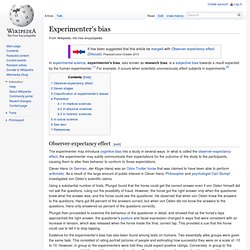
In what is called the observer-expectancy effect, the experimenter may subtly communicate their expectations for the outcome of the study to the participants, causing them to alter their behavior to conform to those expectations. Using a substantial number of trials, Pfungst found that the horse could get the correct answer even if von Osten himself did not ask the questions, ruling out the possibility of fraud. However, the horse got the right answer only when the questioner knew what the answer was, and the horse could see the questioner.
Bias (statistics) A statistic is biased if it is calculated in such a way that it is systematically different from the population parameter of interest.
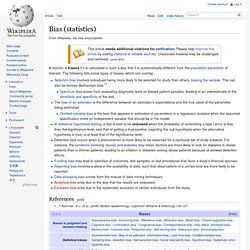
The following lists some types of biases, which can overlap. Selection bias,involves individuals being more likely to be selected for study than others, biasing the sample. This can also be termed Berksonian bias.[1]Spectrum bias arises from evaluating diagnostic tests on biased patient samples, leading to an overestimate of the sensitivity and specificity of the test.The bias of an estimator is the difference between an estimator's expectations and the true value of the parameter being estimated. List of common misconceptions. From Wikipedia, the free encyclopedia This incomplete list is not intended to be exhaustive.

...Explain It Simply...Einstein. Rhetoric & Fallacies. List of cognitive biases. Systematic patterns of deviation from norm or rationality in judgment Cognitive biases are systematic patterns of deviation from norm and/or rationality in judgment. They are often studied in psychology, sociology and behavioral economics.[1] Although the reality of most of these biases is confirmed by reproducible research,[2][3] there are often controversies about how to classify these biases or how to explain them.[4] Several theoretical causes are known for some cognitive biases, which provides a classification of biases by their common generative mechanism (such as noisy information-processing[5]).
Gerd Gigerenzer has criticized the framing of cognitive biases as errors in judgment, and favors interpreting them as arising from rational deviations from logical thought.[6] Explanations include information-processing rules (i.e., mental shortcuts), called heuristics, that the brain uses to produce decisions or judgments. Belief, decision-making and behavioral[edit]
Demonstrations of silencing, a visual illusion. Cognitive bias. Systematic pattern of deviation from norm or rationality in judgment Although it may seem like such misperceptions would be aberrations, biases can help humans find commonalities and shortcuts to assist in the navigation of common situations in life.[5] Some cognitive biases are presumably adaptive.
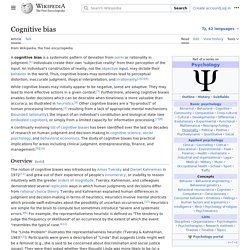
Cognitive biases may lead to more effective actions in a given context.[6] Furthermore, allowing cognitive biases enables faster decisions which can be desirable when timeliness is more valuable than accuracy, as illustrated in heuristics.[7] Other cognitive biases are a "by-product" of human processing limitations,[1] resulting from a lack of appropriate mental mechanisms (bounded rationality), impact of individual's constitution and biological state (see embodied cognition), or simply from a limited capacity for information processing.[8][9] Overview[edit] The "Linda Problem" illustrates the representativeness heuristic (Tversky & Kahneman, 1983[14]). The 12 cognitive biases that prevent you from being rational. The human brain is capable of 1016 processes per second, which makes it far more powerful than any computer currently in existence.
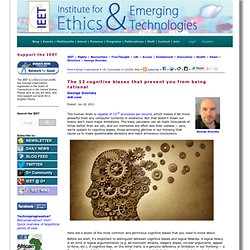
But that doesn't mean our brains don't have major limitations. 15 Styles of Distorted Thinking. Top 10 Thinking Traps Exposed. Our minds set up many traps for us. Unless we’re aware of them, these traps can seriously hinder our ability to think rationally, leading us to bad reasoning and making stupid decisions. Introspection illusion. The surface appearance of an iceberg is often used to illustrate the human conscious and unconscious mind; the visible portions are easily noticed, and yet their shape depends on the much larger portions that are out of view.
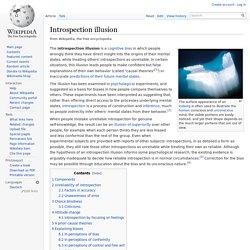
The introspection illusion is a cognitive bias in which people wrongly think they have direct insight into the origins of their mental states, while treating others' introspections as unreliable. In certain situations, this illusion leads people to make confident but false explanations of their own behavior (called "causal theories"[1]) or inaccurate predictions of their future mental states. The illusion has been examined in psychological experiments, and suggested as a basis for biases in how people compare themselves to others. Components[edit] The phrase "introspection illusion" was coined by Emily Pronin.[5] Pronin describes the illusion as having four components:
Biais cognitif. Un article de Wikipédia, l'encyclopédie libre.
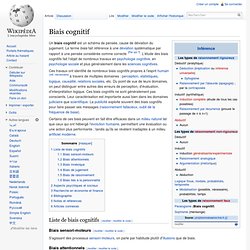
Un biais cognitif est un schéma de pensée, cause de déviation du jugement. Le terme biais fait référence à une déviation systématique par rapport à une pensée considérée comme correcte [Par qui ?]. Les distorsions cognitives. Les distorsions cognitives. La pensée dichotomique : tout ou rien Lorsque le raisonnement est privé de nuances, tout ce qui n’est pas une victoire devient une défaite, tout ce qui n’est pas sans risque devient dangereux, etc.

Ce type de pensée se retrouve logiquement associé au perfectionnisme, aux sentiments dépressifs d’incapacité, de culpabilité, d’autodévalorisation mais également à certains traits de personnalités pathologiques. « Si vous n’êtes pas avec moi, vous êtes contre moi » « J’ai fait un écart, ça ne vaut plus la peine de continuer le régime » « L’employeur ne m’a pas recruté, je ne suis pas fait pour ce boulot » L’abstraction sélective : filtrage mental D’un événement ou d’une expérience ne seront retenus que les détails les plus déplaisants.
. « J’ai gâché mon RDV avec lui car en l’embrassant, je lui ai marché sur le pied » « Mon exposé est raté, j’ai vu quelqu’un rire dans le public » « Ce médecin a consulté le Vidal pendant la consultation, il n’est pas compétent » Cognitive Dissonance. Understanding this experiment sheds a brilliant light on the dark world of our inner motivations.
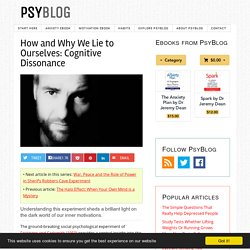
The ground-breaking social psychological experiment of Festinger and Carlsmith (1959) provides a central insight into the stories we tell ourselves about why we think and behave the way we do. The experiment is filled with ingenious deception so the best way to understand it is to imagine you are taking part. So sit back, relax and travel back. The time is 1959 and you are an undergraduate student at Stanford University… As part of your course you agree to take part in an experiment on ‘measures of performance’. Little do you know, the experiment will actually become a classic in social psychology.
Hidden persuaders. 7 Stupid Thinking Errors You Probably Make. The brain isn’t a flawless piece of machinery.

Although it is powerful and comes in an easy to carry container, it has it’s weaknesses. A field in psychology which studies these errors, known as biases. Although you can’t upgrade your mental hardware, noticing these biases can clue you into possible mistakes.How Bias Hurts You If you were in a canoe, you’d probably want to know about any holes in the boat before you start paddling. Biases can be holes in your reasoning abilities and they can impair your decision making. Simply noticing these holes isn’t enough; a canoe will fill with water whether you are aware of a hole or not. Cognitive traps for intelligence analysis. This article deals with a subset of the intellectual process of intelligence analysis itself, as opposed to intelligence analysis management, which in turn is a subcomponent of intelligence cycle management. For a complete hierarchical list of articles in this series, see the intelligence cycle management hierarchy. Intelligence analysis is plagued by many of the cognitive traps also encountered in other disciplines.
The first systematic study of the specific pitfalls lying between an intelligence analyst and clear thinking was carried out by Dick Heuer.[1] According to Heuer, these traps may be rooted either in the analyst's organizational culture or his or her own personality. Types[edit] The most common personality trap, known as mirror-imaging[2] is the analysts' assumption that the people being studied think like the analysts themselves. Inappropriate analogies are yet another cognitive trap. Organizational culture[edit] The "other culture"[edit] The social anthropologist Edward T. The Basic Laws of Human Stupidity. THE BASIC LAWS OF HUMAN STUPIDITY by Carlo M. Cipolla illustrations by James Donnelly The first basic law of human stupidity asserts without ambiguity that: Always and inevitably everyone underestimates the number of stupid individuals in circulation.
At first, the statement sounds trivial, vague and horribly ungenerous. Closer scrutiny will however reveal its realistic veracity. A) people whom one had once judged rational and intelligent turn out to be unashamedly stupid. b) day after day, with unceasing monotony, one is harassed in one's activities by stupid individuals who appear suddenly and unexpectedly in the most inconvenient places and at the most improbable moments. Kathryn Schulz : A propos de nos erreurs. Try The McGurk Effect! - Horizon: Is Seeing Believing? - BBC Two. Unstructured Thoughts by Taylor Davidson (@tdavidson)
Below are the 25 most important lessons I’ve learned through close observation and first-hand experiences in how entrepreneurs and startups fail. The first sixteen primarily address strategic and operational issues, and the last nine deal more with management and organizational issues. I believe the three most important factors for any company are people, product and market, so I’m not sure that the ratio of ways to fail really fits my overall beliefs, but perhaps you’ll have ideas and lessons you’ve learned that will bring the ratio more in line. Read, and then comment: what would you add as reason #26? (Read on Slideshare) 1. Time is the most valuable asset a person has, and yet it’s the easiest and most common thing wasted. What is the second-most important asset?
2. Make decisions before you think you need to. 3. Blindly following the tactics and path of other companies is a sure route to failure. Followers focus on tactics and tools rather than strategies and goals.